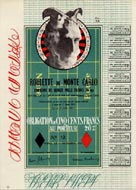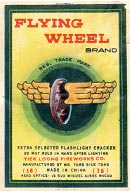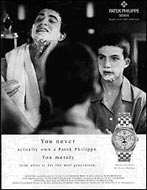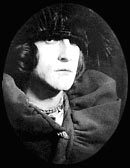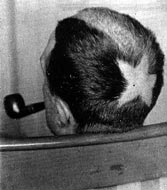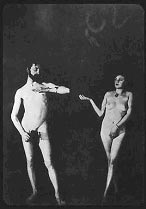Voisins
du Zero: by
Mauricio Cruz
|
||||||||||||||||||||||||||||
|
In a well-known Spanish medical publication called MD, diverse articles relating to anomalies in art were often published: the elongation of El Greco´s figures was the result of a distortion produced by squint; Goya´s black paintings were due to progressive lead poisoning; Van Gogh´s flaming colors, a particular case of schizophrenia. Perhaps because of this and other reasons, I ended up associating Duchamp (MD) with a picturesque uncle of mine, a doctor and subscriber to this magazine in the sixties. A connection that surely underlay one of my dreams where Duchamp appeared camouflaged with my uncle, as if he were another member of the family. The dream consists of a family reunion, which takes place in a room whose atmosphere, from what could be seen through a french window, was redolent of Paris or Buenos Aires. In a cinematographic black and white, the effect of contrasted lights and shadows reproduced a saturated masculine ambiance –somewhere between Bogart and Gardel- characteristic of the first detective movies. No one speaking, we were all there, our silhouettes cutout against the window’s resplendence while a river grew torrentially outside, sweeping debris along the street. Shortly after, much like the effect of an acetate about to burn, the image acquired a reddish tone, gradually dissolving into the face of Marcel, who ended up with his hair tinged of a red oxide, a color between minium and brick, as one of his “bachelors” or, why not, like a cosmopolitan Adam in a two-piece suit about to ignite. 1
Except for chess, which was an obsessive presence in Duchamp´s life, the only one of his works related to these types of games, more specifically to Roulette, is that known as the Monte Carlo Bond (Fig. 1), dated November 1, 1924, the year after leaving his masterpiece The Bride Stripped Bare by her Bachelors, Even (1915-1923) ‘definitely unfinished’. This is also the year that marks his legendary and supposed retirement from art, and his move towards the more rarified and abstract world of chess. The Monte Carlo Bond or Obligation pour la Roulette de Monte Carlo is a ‘rectified and imitated readymade’, a lithograph for a real document, a bond issued in 30 numbered exemplars each with a value of 500 francs. The original bonds, commercial obligations used to release a certain sum on a defined date with a determined rate of interest, were redesigned and released by Duchamp with the purpose of collecting funds in order to experiment with a mathematical system in the game of Trente-et-Quarante, using a Martingale(1) that would allow him to win ‘slowly but surely’ over the Monte Carlo bank, thus making roulette to behave like a chess game. Placed directly over the 'radiant' image of a roulette wheel in the lithograph, is a curious photograph of Duchamp with his hair and face covered in foam. In the lower part of the document, inscribed on the roulette table there are two signatures : Rrose Sélavy's (Duchamp´s feminine alter ego, here starring as President of the Administrative Council,) beneath the black diamond; beneath the red one, as simple administrator, is Marcel's. Printed in the background and repeated 150 times in green ink, is a game of words of the capricious harvest of Rrose Sélavy: moustiques domestiques demistock (domestic mosquitoes half-stock). But let us first see how some authors have described this image:
Is it not curious that in the different readings Duchamp´s face is repeatedly interpreted as a faun, a demon or a satyr, as a masculine being necessarily supplied with horns? This interpretation is fostered not only when thought of in connection with the ‘diabolic’ artistic-financial operation of the Tzanck Check of 1919,(7) but also by images of the aforementioned creatures in classical mythology in which beard and horns appear simultaneously to characterize them. The horns, as history of art dictates, would proceed from the beard.(8) Iconographically, the Roman god Mercury –or Hermes as he was known in ancient Greece— is suggestively pertinent to Duchamp’s financial document. Renowned for his speedy effectiveness, resourcefulness, and shrewdness, Mercury was the Roman god of trade, profit, merchants, travelers, and shepherds, as well as patron to artists, impostors, and all dishonest folk.(9) In addition to the winged cap, Mercury was endowed with wings for his feet called talaria, a caduceus or rod entwined with serpents, and a purse as symbol of his commercial powers.(10) Even his name resonates with these associations; deriving from the Latin root for merchandise, a mercibus, the name Mercury underlies the term ‘mercantile’. Indeed, these are all attributes intensely associated with Duchamp’s conduct, which may be summarized in his anagram: marchand du sel, or salt merchant. Beginning at about this time (1924), this kind of behavior was accentuated when, along with his renewed passion for chess, Duchamp embarked in a series of negotiations and artistic-financial speculations. Such an attitude is well synthesized in the advertisement of the Flying Wheel (Fig. 3), a wheel with wings, identical in essence to the collage over the roulette: a popular synthesis, if you like, of a good part of Duchampian iconography. Thus, Duchamp’s Mercurial image not only bears an iconographic resemblance to the ancient god but is also conceptually tied to the activities surrounding the Monte Carlo Bond. Moreover, Duchamp’s disguise may be read on yet another level, one with deep personal implications, as shall be developed throughout this essay. For what we see in the photomontage is a bearded Mercury, as he appeared in some archaic Greek vases, but which is rather unusual in later imagery, where he is generally shown beardless, almost feminine.(11) Duchamp’s use of foam for creating a beard (as an adolescent in front of a mirror conjuring up virile fantasies) (Fig. 4) exalts this ambiguity, for it simultaneously indicates the absence of a beard after shaving and the appearance of a false beard in place of a real one. Duchamp’s obsessive capillary experiments, and the consequential psychological negotiations between various identities begins casually in 1919, in Buenos Aires, when he shaves his head as a part of a treatment to reduce hair loss. This confers him a rather marginal aspect in the widest sense of the word, whether as an initiate in some sort of sect – chess?(12)-, as a convalescent man –his friends find him excessively thin- or simply delinquent (13). On his return to Paris in the midst of 1919, in a gesture that clearly anticipates the creation of his feminine pseudonym Rrose Sélavy, he creates the well-known readymade of the Mona Lisa (L.H.O.O.Q.) adding a mustache and Mephistophelean small beard to the image. At the end of 1921, after the aromatic transsexual display of Rrose Sélavy presented as Belle Haleine, Eau de Voilette on the altered label of a lugubrious flask of Rigaud perfume,(14) (Fig. 5) he creates a tonsure on his head in the form of a comet with its tail projected towards his forehead. (Fig. 6)Three years later,
immediately after the self-portrait in the Monte Carlo Bond –in
Cinésketch, a theatrical diversion of Picabia and René Clair-
Duchamp reappears as Adam in a tableau vivant based on a sixteenth-century
painting by Cranach, (Fig. 7) displaying
an evidently artificial beard (a significant counterpart to the ambiguous
beard of foam), a watch, and a shaved pubis. Certainly not the last
'shaving' in his work. >>Next
Notes
For Mercury´s thievish activities, see the entry for Mercurius, in John Lemprière, Classical Dictionary.(1788) London: Routledge & Kegan Paul, 1984, p.373-374.
Fig.
1, 5-7 |
||||||||||||||||||||||||||||
